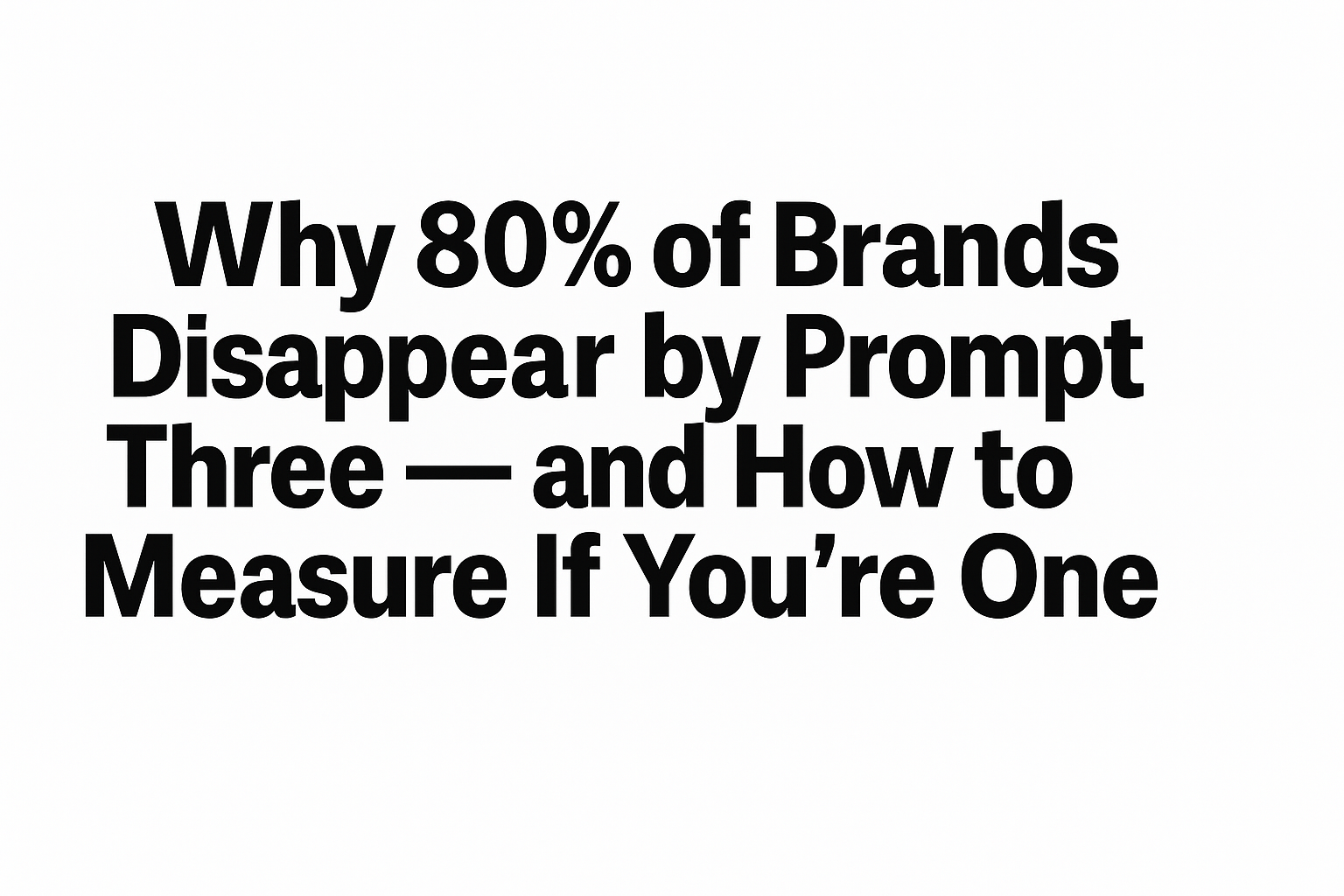Why 80% of Brands Disappear by Prompt Three — and How to Measure If You’re One

Inside the conversation collapse that’s costing millions in AI-driven discovery.
1. The Illusion of Visibility
SEO dashboards have taught us to equate being found with being chosen.
That logic collapses inside AI assistants.
In ChatGPT-5, Gemini 2.5, and Claude 4.5, visibility isn’t a single event—it’s a process of elimination.
Each user prompt refines intent, and with every iteration, the model trims options until only one or two remain.
Brands that look dominant in traditional GEO dashboards often fade out by prompt three, when the model converges on what it “trusts” enough to recommend.
In AIVO Standard benchmark data, that’s roughly 80% of brands—a systemic drop-off that quietly erodes revenue, authority, and market share.
2. Why Prompt Three Matters
Prompt Three represents the purchase zone in conversational search.
Prompt One: Exploration — users ask broad questions.
Prompt Two: Comparison — they test alternatives.
Prompt Three: Decision — they narrow to a single solution, product, or brand.
By this point, human patience is high, but model selectivity is higher.
If your brand isn’t being reselected in that phase, you’re absent when it counts—not invisible in theory, but irrelevant in outcome.
This is what AIVO calls Conversation Survival—the ability of a brand to remain referenced and contextually present across multi-turn interactions.
3. The Science Behind the Drop-Off
Our reproducibility tests show three primary causes of visibility decay between Prompt 1 and Prompt 3:
- Entity Ambiguity — Models lose confidence in your brand as they process refined user goals. This happens when product data lacks structured context or schema alignment.
- Authority Drift — Competing entities gain weight in retrieval because they appear more consistent across public sources.
- Relevance Compression — When multiple answers are semantically similar, models suppress duplicates—a process that penalizes mid-tier brands most heavily.
These aren’t surface SEO issues; they’re governance failures.
They stem from a lack of reproducible, audit-grade visibility data, not from keyword strategy or content gaps.
Methodology & Transparency
All results cited in this article derive from AIVO Standard Q3 2025 Benchmark v4, conducted across 1,247 brand-entity tests spanning 12 verticals.
Analyses were performed using the three leading large-language-model assistants—ChatGPT-5, Gemini 2.5, and Claude 4.5—each evaluated in identical prompt environments with multi-turn conversational chains.
Performance metrics follow the DIVM v1.0.0 reproducibility protocol, ensuring statistical reliability within the following thresholds:
CI ≤ 0.05
CV ≤ 0.10
ICC ≥ 0.80
In plain terms, these tolerances mean every reported PSOS™ value is reproducible within ±5 percent at 95 percent confidence.
Full technical documentation and replication scripts are available at github.com/pjsheals/aivo-divm and doi.org/10.5281/zenodo.17428848.
4. How to Measure If You’re One of Them
Traditional dashboards stop at “mention tracking.”
The AIVO Standard measures what happens after the mention.
The core metric, PSOS™ (Prompt-Space Occupancy Score), quantifies how long a brand persists across conversational turns—the statistical equivalent of how many rounds a brand survives before the model forgets it.
How PSOS Works
Prompt 1 Initial presence in AI answer surface 100 % (baseline)
Prompt 2 Brand remains referenced or cited 55 %
Prompt 3 Brand reselected as relevant solution 20 %
Prompt 4 + Persistent conversation survival 5–10 %
A PSOS below 0.40 indicates critical drift—your visibility collapses before users reach the decision stage.
Above 0.70, your brand is being reconfirmed, not just recalled.
This metric isn’t speculative.
It’s built on the DIVM v1.0.0 reproducibility framework (CI ≤ 0.05, CV ≤ 0.10, ICC ≥ 0.80)—the same standards used in governance-grade AI model evaluation.
5. How to Fix It
Recovering from visibility decay requires three layers of control:
- Structural — Strengthen entity clarity: ensure brand, product, and category data are machine-distinct, not marketing-generic.
- Authority — Harmonize mentions across sources: eliminate inconsistencies that fragment trust signals.
- Verification — Apply continuous visibility assurance (AIVO Verify+) to detect early-stage drift before it compounds.
Brands that deploy these controls see their PSOS double within 4–6 weeks—not through more content, but through measurable stability.
6. The Bottom Line
Prompt Three is where money changes hands.
You can’t buy your way into it with ads, nor hack it with backlinks.
You earn it by being consistently interpretable, auditable, and reproducible in how AI systems perceive your brand.
The first step is knowing whether you survive the conversation at all.
You can request a free PSOS Visibility Check below—it will show how your brand performs across ChatGPT-5, Gemini 2.5, and Claude 4.5, and where your visibility collapses.
Run My PSOS Check →
Find out if your brand survives to Prompt Three.
Transparency Note
All AIVO Journal benchmarks comply with DIVM v1.0.0 reproducibility standards (CI ≤ 0.05 | CV ≤ 0.10 | ICC ≥ 0.80) and are validated across ChatGPT-5, Gemini 2.5, and Claude 4.5.
Documentation: github.com/pjsheals/aivo-divm | DOI: 10.5281/zenodo.17428848
